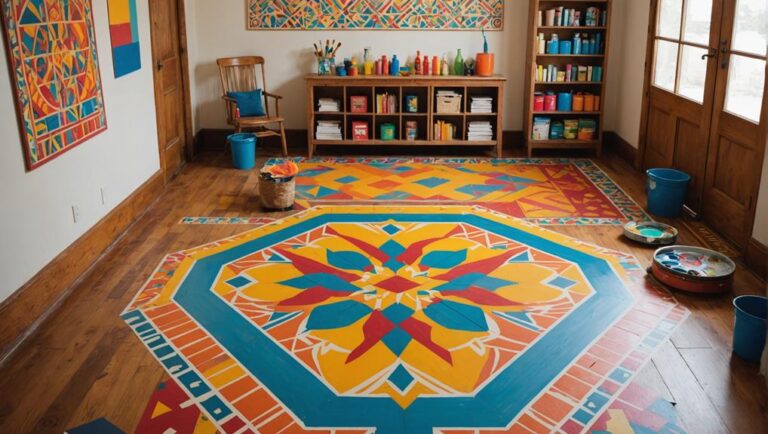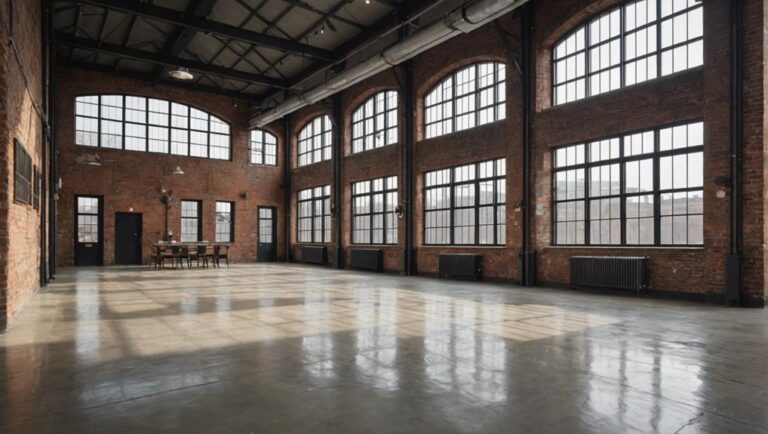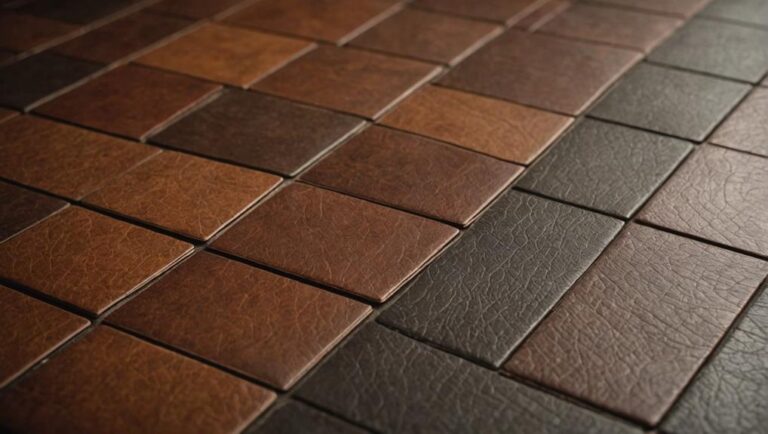Slip-resistant flooring's essential for your restaurant, as it greatly reduces slip-and-fall incidents, protecting both employees and customers. You can choose from materials like rubber, vinyl tiles, textured surfaces, and ceramic, each offering unique safety features. Proper maintenance with daily cleaning helps maintain the flooring's effectiveness. Besides safety, these materials can enhance your establishment's aesthetic, aligning with your brand identity. By investing in high-quality, slip-resistant flooring, you're not just complying with safety regulations; you're fostering a safer dining environment that encourages repeat visits. Discovering the right options can elevate your restaurant's experience even further.
Importance of Slip-Resistant Flooring
When it comes to restaurant safety, slip-resistant flooring is not just a luxury—it's a necessity. The fast-paced environment of a restaurant, combined with spills and food debris, creates a considerable risk of slip-and-fall accidents. Implementing slip-resistant flooring not only helps prevent these incidents but also aligns with regulatory standards set forth to guarantee employee and customer safety.
You might think that safety measures are merely suggestions, but they're critical for compliance and protecting your business. Non-compliance can lead to costly fines, lawsuits, and increased insurance premiums, which can have long-lasting effects on your bottom line. By investing in slip-resistant flooring, you're making a proactive choice that can enhance your establishment's safety profile and minimize liability risks.
It's important to remember that safety doesn't stop at flooring. Extensive employee training is essential to guarantee that your staff understands how to maintain a safe environment. Proper cleaning techniques can notably enhance the effectiveness of slip-resistant surfaces. If employees aren't trained to recognize potential hazards and take appropriate action, even the best flooring can become a liability.
Incorporating slip-resistant flooring and thorough employee training creates a robust safety culture within your restaurant. Not only does it protect your employees from injury, but it also fosters a safe dining experience for your customers. In the competitive restaurant industry, prioritizing safety can set you apart, guaranteeing your establishment thrives while minimizing risk.
Types of Slip-Resistant Materials
Choosing the right slip-resistant materials is essential for guaranteeing safety in a restaurant environment. With various flooring options available, you'll want to take into account their effectiveness, durability, and maintenance needs. Here's a quick overview of some popular slip-resistant materials:
| Material | Features | Safety Certifications |
|---|---|---|
| Rubber Flooring | Soft, cushioned, and ideal for indoor use; excellent grip | ASTM, ANSI |
| Vinyl Tiles | Versatile and easy to clean; available in textured finishes | ASTM, OSHA |
| Textured Surfaces | Enhanced grip; works well in high-traffic areas | UL, ISO |
| Ceramic Options | Durable and water-resistant; can be slip-resistant with proper glazing | ANSI, ASTM |
| Wood Laminates | Offers a warm aesthetic; choose treated options for added grip | ANSI, FSC |
| Outdoor Solutions | Designed to withstand weather; often features drainage systems | ASTM, ANSI |
| Eco-Friendly Materials | Sustainable options available; usually made from recycled materials | LEED, Cradle to Cradle |
When selecting flooring, take into account your restaurant's specific needs, such as the areas prone to spills or heavy foot traffic. Each material offers distinct benefits, and opting for those with recognized safety certifications will help guarantee that you're making a wise choice for safety. By investing in quality slip-resistant materials, you'll not only enhance safety but also create a more inviting atmosphere for your patrons.
Benefits for Restaurant Safety
Implementing slip-resistant flooring in a restaurant is vital for enhancing safety and minimizing the risk of accidents. With high foot traffic and the potential for spills, the right flooring can greatly reduce slip and fall incidents that jeopardize both employees and customers. By prioritizing slip-resistant materials, you create a safer environment that fosters confidence in your staff and patrons.
One of the key benefits of slip-resistant flooring is its role in employee training. When employees are aware of the flooring's capabilities, they can better navigate the space and maintain safety protocols. This knowledge not only empowers them but also reduces anxiety associated with working in a potentially hazardous environment. Regular training sessions on safety practices should include information about the flooring's design and its importance in preventing slips.
Customer awareness is equally important. When patrons see that you've invested in slip-resistant flooring, it signals that you prioritize their safety. This perception can enhance your restaurant's reputation, encouraging repeat visits and positive word-of-mouth referrals. Customers are more likely to enjoy their dining experience when they feel secure in their surroundings.
Ultimately, incorporating slip-resistant flooring isn't just a practical choice; it's a strategic one for improving overall safety. By combining this flooring with thorough employee training and heightened customer awareness, you can create a safer, more inviting atmosphere that sets your restaurant apart from the competition. Prioritizing safety today can lead to greater success tomorrow.
Aesthetic Considerations
When choosing slip-resistant flooring for your restaurant, you can't overlook aesthetic considerations that can enhance your space. Color and design options, along with material texture choices, play an essential role in creating an inviting atmosphere. Additionally, integrating these elements with your branding guarantees that your flooring not only prioritizes safety but also aligns with your overall visual identity.
Color and Design Options
In the domain of restaurant design, the aesthetic appeal of slip-resistant flooring can greatly influence the overall ambiance and guest experience. Selecting the right color and design not only enhances safety but also aligns with current design trends and color psychology. Here are three key considerations:
- Color Psychology: The right colors can evoke emotions—warm tones like reds and oranges can stimulate appetite, while cooler tones such as blues and greens create a calming atmosphere.
- Design Trends: Opt for patterns and textures that complement your restaurant's theme. Geometric designs or natural wood-like finishes can add visual interest while guaranteeing safety.
- Consistency: Confirm that your flooring design aligns with your overall interior theme. Cohesiveness in design enhances the guests' perception of safety and comfort.
Material Texture Choices
Choosing the right material texture for slip-resistant flooring can profoundly impact both safety and aesthetic appeal in your restaurant. When selecting flooring, consider how the texture contributes to surface durability and slip resistance. Textured surfaces can provide the necessary friction to prevent slips, making it safer for both your staff and customers.
You should think about the tactile feedback of various materials. A surface that offers good tactile feedback allows users to feel secure as they walk, which is particularly important in a bustling restaurant environment. Materials like textured vinyl or rubber not only enhance safety but can also blend seamlessly with your restaurant's overall design.
Additionally, the right texture can create an inviting atmosphere. For example, a natural stone finish can convey elegance while ensuring that diners feel secure as they move about. Remember, choosing the right material texture isn't just about aesthetics; it's about creating a safe, durable environment that encourages people to return. By prioritizing slip-resistant options with the right texture, you're investing in both safety and the long-term success of your establishment.
Integration With Branding
Slip-resistant flooring isn't just a safety feature; it can also be a powerful tool for branding your restaurant. When thoughtfully integrated into your design, it enhances your brand identity while guaranteeing a safer environment for your customers. Here are three ways to achieve this:
- Color and Design: Choose flooring that complements your restaurant's color palette and overall aesthetic. A well-chosen style can reinforce your brand's message, making a lasting impression on diners.
- Material Selection: Opt for materials that offer both slip resistance and visual appeal. For instance, textured tiles or hardwood with a non-slip finish can create an inviting atmosphere while prioritizing safety.
- Consistency Across Spaces: Confirm that your flooring aligns with your brand identity throughout different areas of your restaurant. Whether it's the dining area, kitchen, or restrooms, consistent flooring contributes to a cohesive customer experience.
Maintenance and Cleaning Tips
Maintaining and cleaning slip-resistant flooring in restaurants is essential for guaranteeing safety and longevity. Proper upkeep not only enhances the flooring durability but also maximizes its slip resistance, which is vital in a high-traffic environment like yours. Start by sweeping or vacuuming daily to remove dirt and debris that can create slippery surfaces.
For deeper cleanings, use a pH-balanced cleaner compatible with your flooring material. Avoid harsh chemicals that could degrade the surface or diminish its slip resistance over time. It's advisable to mop with a microfiber cloth to prevent scratching, which can compromise the flooring's effectiveness.
Spot clean spills immediately, especially those that could create hazardous conditions, like grease or water. Implement a regular schedule for wet mopping, ideally every few days, to keep the slip-resistant properties intact. In addition, consider using non-slip mats in areas prone to moisture, such as near sinks or dishwashing stations, as an additional safety measure.
Periodic inspections are essential; check for worn or damaged sections of your flooring. Addressing these issues promptly will help maintain the slip resistance and prolong the life of your flooring.
Lastly, educate your staff on proper cleaning techniques and the importance of maintaining these surfaces. By committing to this maintenance routine, you'll not only guarantee the safety of your patrons but also extend the lifespan of your flooring investment. Prioritize safety; it pays off in the long run.
Cost Factors and Budgeting
When budgeting for slip-resistant flooring, your choice of materials greatly influences overall costs. Higher-quality options may come with a heftier price tag but can offer better durability and safety features, ultimately saving you money on replacements and maintenance. Additionally, it's essential to factor in installation expenses, as skilled labor may increase upfront costs but guarantee a proper fit and longevity of your flooring investment.
Material Selection Impact
Selecting the right materials for slip-resistant flooring can greatly impact both your budget and overall operational costs. It's crucial to evaluate not just the initial expense but the long-term benefits of durability and safety. Here are three key factors to keep in mind:
- Material Durability: Investing in high-quality materials can reduce the frequency of replacements, saving you money over time.
- Maintenance Costs: Some materials require more upkeep than others. Choosing easy-to-clean options can lower your overall maintenance expenses.
- Environmental Impact: Select materials that are eco-friendly; they often come with certifications that could enhance your restaurant's reputation and potentially attract more customers.
Installation Expenses Overview
After considering material selection, understanding installation expenses is important for budgeting your restaurant's slip-resistant flooring project. The cost of installation can greatly impact your overall budget, so it's important to identify the main factors involved.
First, consider the installation techniques you'll use. Different flooring materials require varying methods, which can affect both time and costs. For instance, tiles may need meticulous alignment and grouting, while vinyl can often be laid down more quickly.
Next, labor costs can vary depending on your location and the complexity of the installation. Skilled professionals are critical for guaranteeing the flooring is not only installed correctly but also meets safety standards. Do you have a reliable contractor in mind? Be sure to obtain multiple quotes to compare labor expenses, as this can lead to considerable savings.
Lastly, don't forget to include potential additional costs like preparation of the subfloor or removal of existing flooring. By thoroughly evaluating these installation expenses, you can guarantee your restaurant's slip-resistant flooring is both safe and budget-friendly, ultimately protecting your business investment.
Installation Process and Timeline
A successful installation of slip-resistant flooring typically involves three key phases: preparation, installation, and finishing. Each phase plays an essential role in ensuring safety and durability in your restaurant's environment. Understanding the installation techniques and project timelines can help you plan effectively.
Here's a quick overview of the process:
- Preparation: This phase includes evaluating the existing flooring, ensuring the subfloor is clean and level, and selecting the appropriate slip-resistant material. Proper preparation is imperative to avoid issues later on.
- Installation: During this phase, skilled professionals will implement the chosen installation techniques. Whether you opt for adhesive, interlocking tiles, or other methods, precise application is essential. Expect this phase to take anywhere from one to three days, depending on the size of your establishment.
- Finishing: After the flooring is installed, finishing touches like sealing and grouting are applied. This not only enhances the aesthetics but also adds an extra layer of safety and protection. Typically, this phase can be completed in a day.
Frequently Asked Questions
How Do I Choose the Right Color for Slip-Resistant Flooring?
When you're choosing the right color for flooring, think about how different hues can influence emotions. Color psychology suggests that warm tones can create a welcoming atmosphere, while cool shades might evoke calmness. You'll want to balance design aesthetics with safety; darker colors can hide stains but might absorb heat. Always consider the overall ambiance you wish to create, ensuring it aligns with your vision while promoting a safe environment for everyone.
Are There Eco-Friendly Options for Slip-Resistant Flooring?
Yes, there are eco-friendly options for slip-resistant flooring that prioritize sustainability practices. When selecting flooring materials, consider bamboo, cork, or recycled rubber, as they offer both durability and safety. These materials not only reduce environmental impact but also provide effective slip resistance. By choosing eco-friendly options, you're promoting a safer environment for everyone while aligning with modern sustainability practices. Make an informed choice that benefits both your space and the planet.
Can Slip-Resistant Flooring Be Installed Over Existing Flooring?
Yes, slip-resistant flooring can often be installed over existing flooring, but it depends on flooring compatibility. You need to take into account the installation methods available, as some may require a smooth surface for proper adhesion. Verify that the existing flooring is in good condition to avoid issues down the line. This approach can save time and money while enhancing safety in your space, so it's worth exploring for your project.
What Is the Lifespan of Slip-Resistant Flooring Materials?
Imagine your floor lasting forever—what a dream, right? While no flooring lasts a lifetime, slip-resistant materials typically boast impressive durability, often spanning 10 to 20 years with proper care. Maintenance requirements are essential; regular cleaning and occasional resealing can greatly extend their life. Choosing high-quality materials guarantees you're investing in safety and longevity, giving you peace of mind while keeping your space slip-free. It's all about making a smart choice for safety!
How Does Weather Affect Outdoor Slip-Resistant Flooring?
Weather plays an important role in the performance of outdoor slip-resistant flooring. Seasonal challenges like rain, snow, and ice can create slippery conditions, affecting safety. Regular outdoor maintenance is essential to guarantee these surfaces remain effective. Debris and moisture can diminish traction, so you'll want to keep them clean and inspect for wear. Investing in high-quality materials designed to withstand the elements can greatly enhance safety and longevity for your outdoor spaces.




